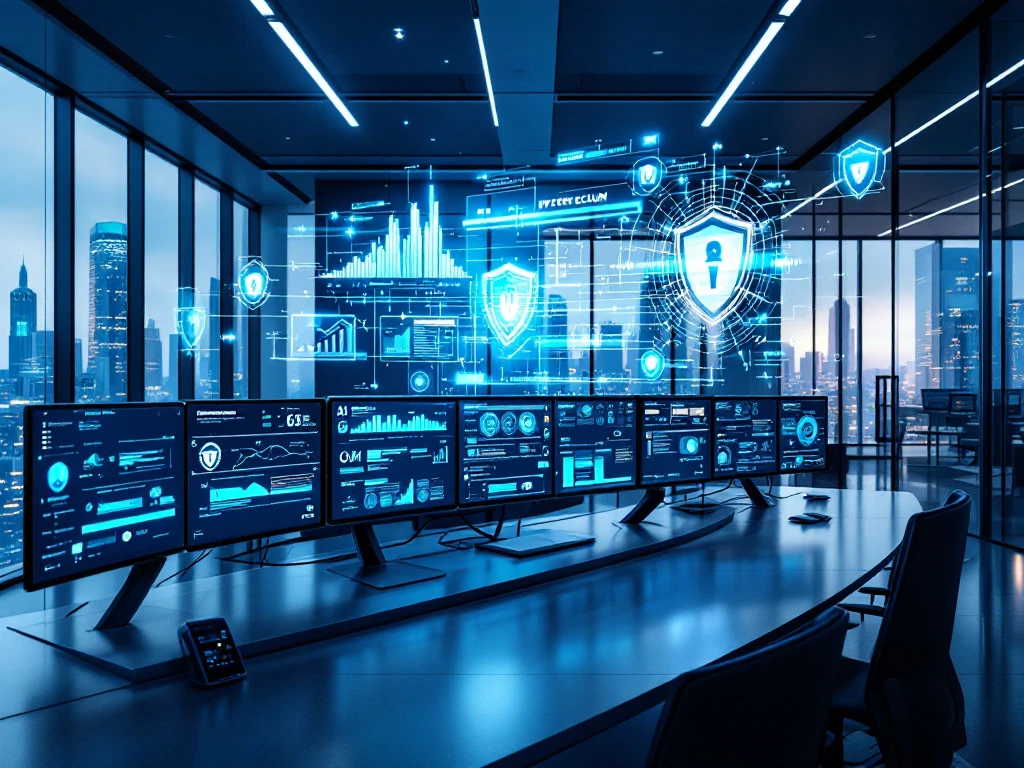

-
UK: +44 203 8876 770
US: 315 508 6500 - cybersecurity@thisisiceberg.com
-
8 Devonshire Square, London, EC2M 4YJ

The cybersecurity landscape has transformed dramatically with artificial intelligence powering increasingly sophisticated automated attacks. Traditional security teams, built around manual processes and reactive responses, find themselves struggling to keep pace with threats that evolve faster than human defenders can adapt. This creates a critical gap in organisational security that puts sensitive data and systems at risk.
Building AI-resistant security teams requires a fundamental shift in how you approach cybersecurity hiring and team development. You need professionals who can think strategically, adapt quickly, and leverage technology to counter automated cyber threats effectively. This guide explores the specific competencies your security professionals need and provides practical strategies for building teams capable of defending against AI-powered attacks.
Automated attacks operate at machine speed, launching thousands of variations in the time it takes a human analyst to investigate a single incident. These AI-driven threats continuously learn from failed attempts, adapting their approach in real-time to bypass security measures. Traditional security teams, relying on manual analysis and rule-based systems, simply cannot match this pace of evolution.
The problem extends beyond speed. Automated attacks exploit multiple attack vectors simultaneously, creating complex, multi-stage intrusions that overwhelm conventional detection systems. While your security analyst investigates one suspicious event, the automated attack has already pivoted to three alternative approaches, testing different entry points and escalation methods.
Most security teams operate reactively, responding to threats after they’ve been detected. This approach worked when attacks followed predictable patterns, but AI-powered threats generate novel attack signatures that traditional signature-based detection systems miss entirely. By the time your team identifies and responds to a new attack pattern, the automated system has already moved on to the next variation.
Resource allocation becomes another critical challenge. Traditional security teams spend significant time on routine tasks:
Meanwhile, automated attacks exploit this predictable resource allocation, timing their most sophisticated attempts when they know human analysts are occupied with routine security operations.
A single automated attack system can probe thousands of potential vulnerabilities across your network infrastructure while your security team handles a handful of investigations. This fundamental scale mismatch means that even highly skilled security professionals become bottlenecks in your defence strategy when facing automated threats.
The economic advantage also favours attackers. One sophisticated automated attack system can target hundreds of organisations simultaneously, while each targeted organisation must invest in dedicated security resources to defend against these threats. This asymmetry makes traditional, labour-intensive security approaches increasingly unsustainable.
AI-resistant security professionals possess a unique combination of technical depth, strategic thinking, and adaptability that enables them to counter automated threats effectively. These individuals understand both the capabilities and limitations of AI systems, allowing them to anticipate attack patterns and develop countermeasures that exploit the weaknesses in automated approaches.
| Core Competency | Description | Impact on AI Resistance |
|---|---|---|
| Systems Thinking | Views security as interconnected ecosystem | Identifies multi-system attack patterns |
| Continuous Learning | Actively studies emerging attack techniques | Anticipates future attack evolution |
| Technical Versatility | Deep specialisation with broad knowledge | Recognises automated vs human-directed attacks |
The most valuable security professionals demonstrate systems thinking, viewing security not as a collection of individual controls but as an interconnected ecosystem. This perspective enables them to identify attack patterns that span multiple systems and understand how automated threats might chain together seemingly unrelated vulnerabilities to achieve their objectives.
Effective security professionals in an AI-driven threat landscape combine deep expertise in their specialisation with broad knowledge across multiple domains. A network security specialist might also understand machine learning concepts, enabling them to recognise when network traffic patterns suggest automated reconnaissance rather than human-directed attacks.
These professionals leverage automation themselves, using scripting, orchestration, and machine learning tools to scale their defensive capabilities. They understand that fighting automated attacks requires automated defences, but they also know when human judgment and creativity are irreplaceable in the security process.
Problem-solving agility distinguishes AI-resistant security professionals from their traditional counterparts. When faced with novel attack patterns, they quickly develop hypotheses, test countermeasures, and iterate their approach based on results. This experimental mindset enables them to stay ahead of automated attacks that rely on predictable defensive responses.
Modern cybersecurity requires extensive collaboration across technical and business teams. AI-resistant security professionals excel at translating complex technical threats into business impact terms, enabling informed decision-making about security investments and risk tolerance. They also coordinate effectively with other security specialists, understanding how their work fits into broader defensive strategies.
When evaluating security professionals, look for evidence of collaborative problem-solving and communication skills alongside technical competencies. The most effective defenders understand that cybersecurity is ultimately a team sport, especially when facing sophisticated automated threats.
Successful AI-resistant security teams combine diverse skill sets and perspectives to create comprehensive defensive capabilities. Rather than hiring identical specialists, focus on building complementary expertise that covers the full spectrum of automated threat scenarios your organisation might face.
Your core team structure should include:
Each role requires different competencies, but all team members must understand how their work contributes to the overall defensive strategy.
Effective teams leverage automation to handle routine tasks and scale their defensive capabilities while preserving human judgment for complex analysis and strategic decision-making. This balance requires careful consideration of which security processes benefit from automation and which require human creativity and intuition.
Consider implementing rotation programs that expose team members to different aspects of your security operation. This cross-training creates more adaptable professionals who understand how various security functions interconnect and can step into different roles when facing complex, multi-faceted automated attacks.
AI-resistant security teams require structured approaches to continuous learning and capability development. Establish regular threat landscape reviews where your team analyses emerging attack patterns, discusses defensive implications, and identifies skill gaps that need addressing.
Encourage experimentation and controlled testing of new defensive techniques and technologies. Your team should have access to lab environments where they can safely explore new tools, test defensive scenarios, and develop expertise with emerging security technologies before implementing them in production environments.
Attracting security professionals with AI and automation expertise requires a different approach than traditional cybersecurity recruitment. These candidates often have multiple opportunities and prioritise organisations that demonstrate commitment to cutting-edge security practices and professional development.
Your job descriptions should emphasise opportunities for innovation, access to advanced security tools, and the chance to work on challenging problems involving automated threats. Highlight specific technologies, methodologies, and attack scenarios that candidates will encounter, demonstrating that your organisation operates at the forefront of cybersecurity practice.
During interviews, focus on problem-solving approaches rather than specific technical knowledge. Present candidates with scenarios involving novel attack patterns and evaluate how they structure their analysis, identify key variables, and develop potential countermeasures.
Develop interview questions that explore candidates’ understanding of AI and machine learning concepts as they apply to cybersecurity:
Consider practical assessments that simulate real-world scenarios involving automated attacks. Present candidates with log data or network traffic patterns that suggest automated reconnaissance or attack activity, and evaluate their analysis process and conclusions.
AI-savvy security professionals seek organisations that invest in advanced security capabilities and provide opportunities for professional growth. Emphasise your commitment to staying ahead of emerging threats, your investment in cutting-edge security tools, and your support for employee learning and development.
Consider offering flexible work arrangements, professional development budgets, and opportunities to attend security conferences or pursue advanced training. These benefits particularly appeal to security professionals who prioritise continuous learning and staying current with rapidly evolving threat landscapes.
Reading about building AI-resistant security teams? You're not alone - many hiring managers are grappling with finding professionals who can counter automated attacks. The challenge of hiring security talent with the right mix of AI knowledge and strategic thinking is becoming critical.
Transforming your existing security team to handle automated threats requires structured training programs that build both technical skills and strategic thinking capabilities. Start by assessing current team competencies and identifying specific gaps related to AI threats and automated attack techniques.
Develop hands-on training scenarios that simulate automated attacks against your organisation’s actual infrastructure and systems. This practical approach helps team members understand how automated threats might target your specific environment while building experience with detection and response techniques.
Provide training in security automation tools and platforms that your team will use to counter automated attacks:
| Skill Area | Training Focus | Expected Outcome |
|---|---|---|
| Detection Rules | Writing and optimising automated detection logic | Faster threat identification |
| Response Automation | Configuring automated response actions | Reduced response times |
| Tool Integration | Creating comprehensive defensive workflows | Enhanced coordination |
Create internal knowledge-sharing sessions where team members present new techniques, tools, or threat intelligence to their colleagues. This approach builds collective expertise while encouraging individual learning and experimentation with emerging security technologies.
Train your team to think strategically about automated threats, understanding not just individual attack techniques but broader attack campaigns and threat actor objectives. This strategic perspective enables more effective prioritisation of defensive efforts and resource allocation.
Conduct regular tabletop exercises that simulate complex, multi-stage automated attacks against your organisation. These exercises help team members practice coordination, decision-making, and communication skills while building familiarity with automated threat scenarios.
Establish mentorship programs that pair experienced security professionals with team members who are developing AI and automation expertise. This knowledge transfer accelerates skill development while ensuring that institutional security knowledge is preserved and enhanced.
Building teams capable of defending against automated cyber threats requires a fundamental shift in how you approach cybersecurity hiring and team development. The security professionals who will succeed in this environment combine deep technical expertise with strategic thinking, adaptability, and strong collaboration skills. They understand that fighting automated attacks requires both technological sophistication and human creativity.
Your organisation’s security depends on assembling teams with the right mix of skills, providing them with appropriate tools and training, and creating an environment that encourages continuous learning and adaptation. The investment in AI-resistant security capabilities pays dividends not just in improved threat defence but in building organisational resilience that can adapt to future security challenges.
At Iceberg, we understand the unique challenges of building security teams capable of countering automated threats. Our global network of cybersecurity professionals includes specialists with the AI and automation expertise your organisation needs to stay ahead of evolving cyber threats. We help you identify and attract the talent that will strengthen your security posture in an increasingly automated threat landscape.
If you are interested in learning more, reach out to our team of experts today.













